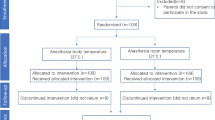Abstract
In a double-blind study, room-temperature lidocaine was injected randomly into 1 eyelid of 40 patients during facial anesthesia. The other eyelid of the same eye received injection of warm lidocaine (group 1) or bicarbonate-buffered lidocaine (group 2). Based on a pain scale, warming or buffering lidocaine did not significantly reduce the amount of infiltration pain. Buffering lidocaine was effective in reducing the quality of pain, as judged by the patient's report of dominant pain.
Similar content being viewed by others
References
Wightman MA, Vaughan RW. Comparison of compounds used for intra-dermal anaesthesia. Anesthesiology. 1976;45:687–690.
Morris RW, Whish DKM. A controlled trial of pain on skin infiltration with local anaesthetics. Anesth Intensive Care. 1984;12:113–114.
Morris R, McKee W, Muslin P. Comparison of pain associated with intra-dermal and subcutaneous infiltration with various local anesthetic solutions. Anesth Analg., 1987;66:1180–1182.
Gormly DE. Local anesthesia: pain control with proper injection technique. J Dermatol Surg Oncol. 1987;13:35–36.
Bainbridge LC. Comparison of room temperature and body temperature local anaesthetic solutions. Br J Plast Surg. 1991;44:147–148.
Davidson JA, Boom SJ. Warming lignocaine to reduce pain associated with injection. Br Med J. 1992;305:617–618.
Christoph RA, Buchanan L, Kimberly B, Schwartz S. Pain reduction in local anesthetic administration through pH buffering. Ann Emerg Med. 1988;17:117–120.
Martin AJ. pH-adjustment and discomfort caused by the intradermal injection of lignocaine. Anaesthesia. 1990;45:975–978.
Krause M, Weindler J, Ruprecht KW. Does warming of anesthetic solutions improve analgesia and akinesia in retrobulbar anesthesia? Ophthalmology. 1997;3:429–432.
Kaplan PA, Lieberman PE, Vonk BM. Does heating lidocaine decrease the pain of injection? Am J Radiol. 1987;149:1291.
Dalton AM, Sharma A, Redwood M, Wadsworth J, Touquet R. Does the warming of the local anesthetic reduce the pain of its injection? Arch Emerg Med. 1989;6:247–250.
Knapp H. On cocaine and its use in ophthalmic and general surgery. Arch Ophthalmol. 1884;13:402–448.
Krohn J, Hovdig G, Seland H, Aasved, H. Retrobulbar anaesthesia with and without adrenaline in extracapsular cataract surgery. Acta Ophthalmol. 1995;73:56–60.
Boggia R. Heating local anaesthetic cartridges. Br Dent J. 1967; 122:287.
Finkel LI, Berg DJ. Heating lidocaine appears to prevent painful injection. AJR. 1987;148:651.
Cragg AH, Berbaum K, Smith TP. A prospective blinded trial of warm and cold lidocaine for intra-dermal injection. AJR. 1988;148: 651.
Bloom LH, Scheie HG, Yanoff M. The warming of local anesthetic agents to decrease discomfort. Ophthalmic Surg. 1984;15:603.
Bell RWD, Butt ZA. Warming lignocaine reduces the pain of injection during peri-bulbar local anaesthesia for cataract surgery. Br J Ophthalmol. 1995;79:1015–1017.
Mehta PM, Theriot E, Mehrotra D, Patel K, Kimball BG. A simple technique to make bupivacaine a rapid acting epidural anaesthetic. Reg Anaesth. 1987;12:135–137.
Difazio CA, Carron H, Grosslight KR, Moscicky JC, Bolding WR, Johns RA. Comparison of pH-adjusted lidocaine solutions for epidural anesthesia. Anesth Analg. 1986;65:760–764.
Moorland GH, Douglas MJ, Jeffrey WK, et al. Effect of pH adjusted bupivacaine on onset and duration of epidural analgesia in parturients. Can Anaesth Soc J. 1986;33:537–542.
Tackley RM, Coe AJ. Alkalised bupivacaine and adrenaline for epidural Caesarean section: a comparison with 0.5% bupivacaine. Anaesthesia. 1988;43:1019–1021.
McKay W, Morris R, Mushlin P. Sodium bicarbonate attenuates pain on skin infiltration with lidocaine with and without epinephrine. Anesth Analg. 1987;66:572.
Author information
Authors and Affiliations
Rights and permissions
About this article
Cite this article
Talu, H., Elibol, O., Yanyali, A. et al. Effect of warming and buffering lidocaine on pain during facial anesthesia. Ann Ophthalmol 33, 43–47 (2001). https://doi.org/10.1007/s12009-001-0072-3
Issue Date:
DOI: https://doi.org/10.1007/s12009-001-0072-3




